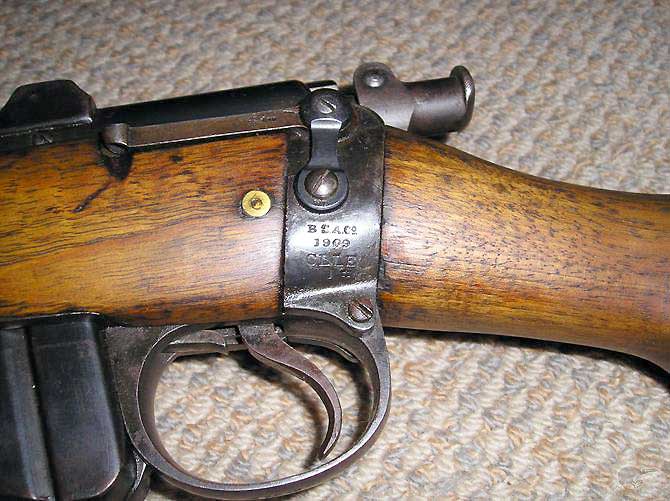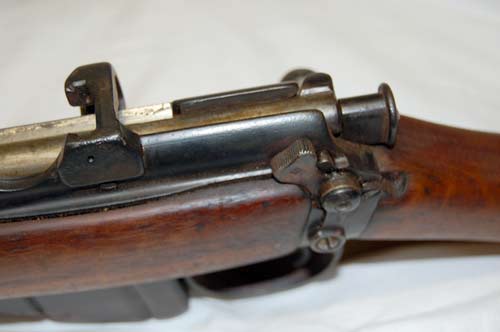Design and history

The Lee-Enfield rifle was derived from the earlier Lee-Metford, a mechanically similar black powder rifle, which combined James Paris Lee's rear-locking bolt system with a barrel featuring rifling designed by William Ellis Metford. The Lee action cocked the striker on the closing stroke of the bolt, making the initial opening much faster and easier compared to the "cock on opening" of the Mauser design. The rear-mounted lugs place the operating handle much closer to the operator, over the trigger, making it much quicker to operate than traditional designs like the Mauser, which force the operator to move his hand forward to operate the bolt; also, the bolt's distance of travel was identical with the length of the cartridge, and its rotation was only 60 degrees (compared to the conventional 90-degree rotation of Mauser-style actions). The disadvantage was that the rear lugs placed a greater load on the rigidity of the bolt up to the receiver.

The Lee-Enfield relied on various woods for its stock but chiefly walnut, both North American black walnut and European 'English' walnut, renowned for their qualities. The decorative figure of these timbers, prized amongst game shooters, was not required for military rifles, but it is not uncommon to find military Lee-Enfield rifles with almost presentation-quality wood stocks.
The rifle was also equipped with a detachable sheet-steel, 10-round, double-column magazine, a very modern development in its day. Originally, the concept of a detachable magazine was opposed in some British Army circles, as some feared that the private soldier might be prone to lose the magazine during field campaigns. Early models of the Lee-Metford and Lee-Enfield even used a short length of chain to secure the magazine to the rifle. Critics also predicted that a repeating rifle with such a large magazine capacity would discourage soldiers from taking careful aim, relying instead on sheer volume of fire to repel the enemy. Both of these concerns were proved to be unfounded.

The fast-operating Lee bolt-action and large magazine capacity enabled a trained rifleman to fire between 20 to 30 aimed rounds a minute, making the Lee-Enfield the fastest military bolt-action rifle of the day. The current world record for aimed bolt-action fire was set in 1914 by a musketry instructor in the British Army — Sergeant Instructor Snoxall — who placed 38 rounds into a 12" target at 300 yards (270 m) in one minute. Some straight-pull bolt-action rifles were thought faster, but lacked the simplicity, reliability, and generous magazine capacity of the Lee-Enfield. War stories from WWI tell of British troops sending the Germans home reporting they'd suffered withering machine gun fire, when, in fact, it was simply a group of trained riflemen armed with standard-issue SMLE Mk III rifles.
The Lee-Enfield was adapted to fire the .303 British service cartridge, a rimmed, high-powered rifle round. Experiments with smokeless powder in the existing Lee-Metford cartridge seemed at first to be a simple upgrade, but the greater heat and pressure generated by the new smokeless powder quickly wore away the shallow, rounded, Metford rifling. Replacing this with a new square-shaped rifling system designed at the Royal Small Arms Factory (RSAF) Enfield solved the problem, and the Lee-Enfield was born. Despite calls for a new rimless cartridge design better suited to the double-column magazine and the new machine guns then in development, the government demanded that the new design use the existing rimmed cartridge design in order to use existing ammunition stocks. This decision had the unintended effect of ensuring that the .303 British cartridge survived well into World War II and Korea, by which time the need for a rimless cartridge had become a priority to enable the Commonwealth militaries to field self-loading rifles (which require rimless cartridges for more-reliable magazine feeding).

The Lee-Enfield rifle was introduced in November 1895 as the .303 calibre, Rifle, Magazine, Lee-Enfield, or more commonly simply Magazine Lee-Enfield, or MLE (sometimes spoken as "emily" instead of M, L, E). The next year a shorter version was introduced as the Lee-Enfield Cavalry Carbine Mk I, or LEC, with a 21.2 inch (538mm) barrel as opposed to the 30.2 inch (767mm) one in the "long" version. Both underwent a minor upgrade series in 1899, becoming the Mk I*. Many LECs (and LMCs in smaller numbers) were converted to special patterns, namely the New Zealand Carbine and the Royal Irish Constabulary Carbine, or NZ and RIC carbines, respectively. Some of the MLEs (and MLMs) were converted to load from chargers, and designated Charger Loading Lee-Enfields, or CLLEs.

